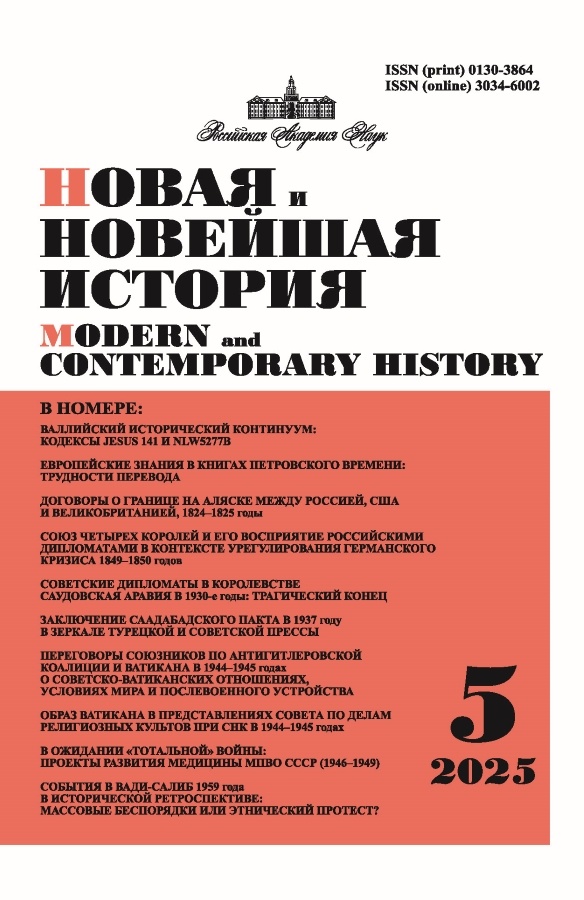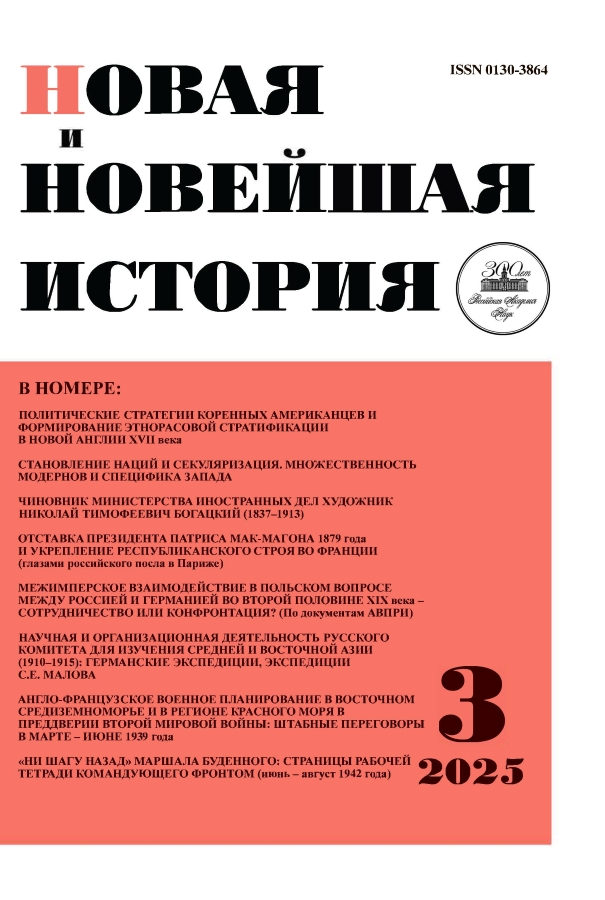Политические стратегии коренных американцев и формирование этнорасовой стратификации в Новой Англии XVII века
- Авторы: Александров Г.В.1
-
Учреждения:
- Российский государственный гуманитарный университет
- Выпуск: № 3 (2025)
- Страницы: 41-54
- Раздел: Новое время
- URL: https://ruspoj.com/0130-3864/article/view/685319
- DOI: https://doi.org/10.31857/S0130386425030043
- ID: 685319
Цитировать
Полный текст
Аннотация
Политическая активность коренного населения в раннеколониальной Новой Англии часто недооценивается. Индейцы предстают как в популярной культуре, так зачастую и в исследовательской литературе как пассивные жертвы обстоятельств, не способные влиять на процессы, стремительно менявшие мир вокруг них. Это представление, напрямую вытекавшее из идеи «благородного дикаря», популярной в XIX в., не соответствует действительности. В статье рассматриваются политические стратегии, использовавшиеся предводителями коренных американцев на протяжении XVII в. Речь идет как о деятельности отдельных сахемов, искавших различные способы наладить продуктивное взаимодействие с колониями, так и о коллективных стратегиях, наиболее важной из которых стало для многих коренных жителей Атлантического побережья Америки принятие христианства. Особенно значимые примеры успешной адаптации индейцев к изменившимся обстоятельствам – первым заключивший союз с англичанами Усамекин, предводитель мохеган Ункас и пекот Робин Кассакинамон, один из главных посредников во взаимодействиях колонистов и индейцев во второй половине XVII в. Их подходы к выстариванию взаимоотношений с колониями различались в силу разных обстоятельств, в которых они оказывались, но все же обладали рядом общих черт. Редко связанные с прямым сопротивлением колониальной экспансии, эти стратегии иллюстрируют гибкость и способность к адаптации, характерные для политической культуры коренных американцев, а также значимость их для колониальной истории: от непосредственного влияния на события XVII в. до более долгосрочных последствий, связанных с формированием этнорасовой стратификации колониального и позже американского общества.
Полный текст
Об авторах
Глеб Владимирович Александров
Российский государственный гуманитарный университет
Автор, ответственный за переписку.
Email: glaleksandrov@gmail.com
ResearcherId: AGN-7482-2022
кандидат исторических наук, научный сотрудник
Россия, МоскваСписок литературы
- Aleksandrov G. The Politics of Intercultural Education: Native-colonial Relations in the XVII century New England Language Manuals // Proceedings of the Russian-American Research Nexus Forum. Vol. 1. Moscow, 2022. Р. 29–56.
- Axtell J. The Invasion Within: The Contest of Cultures in Colonial North America. Oxford, 1986.
- Bradford W. Of Plymouth Plantation (1620–1647). New York, 1981.
- Calloway C.G. New Worlds for All: Indians, Europeans, and the Re-making of Early America. Baltimore, 2013.
- Calloway C.G. Pen and Ink Witchraft: Treaties and Treaty Making in American Indian History. Oxford, 2013.
- Cave A. The Pequot War. Cambridge, 1996.
- Cogley R. John Eliot’s Mission to the Indians before King Philip’s War. Cambridge, 1999.
- Cook S.F. 1973. The Significance of Disease in the Extinction of the New England Indians // Human Biology. 1973. Vol. 3. P. 489–490.
- De Forest J. History of the Indians of Connecticut from the Earliest Known Period to 1850. Hartford, 1851.
- Fisher J., Silverman D. Ninigret, Sachem of the Niantics and Narragansetts: Diplomacy, War, and the Balance of Power in Seventeenth-Century New England and Indian Country. Ithaca, 2014.
- Gardener L. Left Lion Gardener his Relation of the Pequot Warres // MHS Collection, 3rd series. Vol. 3. Boston, 1833. Р. 131–161.
- Gookin D. Historical Collections of the Indians in New England. New York, 1970.
- Hoornbeek B. An Investigation into the Cause or Causes of the Epidemic Which Decimated the Indian Population of New England, 1616–1619 // New Hampshire Archeologist. 1976. Vol. 19. P. 38.
- Jennings F. Empire of Fortune. New York, 1990.
- Jennings F. The Ambiguous Iroquois Empire: The Covenant Chain Confederation of Indian Tribes with English Colonies. New York, 1984.
- Jennings F. The Invasion of America: Indians, Colonialism and the Cant of Conquest. Chapel Hill, 1975.
- Johnson E. “Some by flatteries and others by threatenings”: Political strategies among Native Americans of seventeenth-century southern New England. 1993 // URL: https://www.proquest.com/openview/be12c51664bf7fa9d12c92cc089c8e56/1?pq-origsitegscholar&cbl18750&dissy (access date: 04.09.2024).
- Johnson E. Wonder-working Providence of Sion’s Saviour in New England (1654). New York, 1910.
- Knapp A.P. Connecticut’s Yesteryear: So Saith the Wind. Old Saybrook (CT), 1985.
- Mason J. A Brief History of the Pequot War. Boston, 1736.
- McBride K. The Legacy of Robin Cassacinamon: Mashantucket Pequot Leadership in the Historic Period. Northeastern Indian Lives, 1632–1816. Amherst, 1996.
- Oberg M.L. Uncas, First of the Mohegans. Ithaca, 2003.
- Pulsipher J. “Subjects... Unto the Same King”: New England Indians and the Use of Royal Political Power // Massachusetts Historical Review. 2003. Vol. 5. Р. 29–57.
- Records of the United Colonies of New England. Boston, 1853.
- Salisbury N. Manitou and Providence: Indians, Europeans and the Making of New England, 1500–1643. New York, 1984.
- Saltonstall N. A New and Further Narrative of the State of New England being a Continued Account of the Bloody Indian War // King Philip’s War Narratives. New York, 1966.
- Stone W.L. Uncas and Miantonomoh: A Historical Discourse. New York, 1842.
- Sylvester H. Indian Wars of New England. Vol. 1. Boston, 1910.
- Weeks A.G. Massasoit of the Wampanoags: With a Brief Commentary on Indian Character, and Sketches of Other Great Chiefs, Tribes, and Nations. Norwood (Mass.), 1919.
- Williams R. A Key into the Language of America (1643). Detroit, 1973.
- Williams R. The Correspondence of Roger Williams, 1629–1653. Vol. I. Hanover; London, 1988.
- Winthrop J. The Winthrop Papers. Vol. 5. New York, 1968.
- Winthrop J. Winthrop’s Journal. New York, 1908.
- Woodward W. Prospero’s America: John Winthrop, Jr., Alchemy, and the Creation of New England Culture, 1606–1676. Chapel Hill, 2010.
Дополнительные файлы











